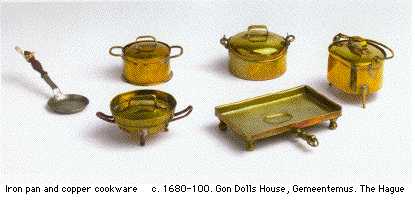Copper pans, iron pots
 A
copper pan for small pancakes, a copper kettle, two copper pots, a
copper milk pan, four iron pots
'Een kopere broederspanne [poffertjespan]; een kopere
ketel; twee kopere potten; een kopere melckpan; vier ysere
potten'. All of these were in the back kitchen, the agter
keukentgen, room J.
A
copper pan for small pancakes, a copper kettle, two copper pots, a
copper milk pan, four iron pots
'Een kopere broederspanne [poffertjespan]; een kopere
ketel; twee kopere potten; een kopere melckpan; vier ysere
potten'. All of these were in the back kitchen, the agter
keukentgen, room J.
Copper cooking utensils were the expensive alternative to
earthenware and iron cooking pots. They required constant
scouring.
The traveller Ellis Veryard noted in 1701: "No people in Europe
are so neat in their house; the meaner sort being extremely nice in
setting them out to the best advantage. The women spend the greatest
part of their time in washing, rubbing and scouring, that their pots
and pans are kept brighter without than within. The floors of their
lower rooms are commonly chequered black and white marble
[sic!] and the walls and chimneys covered with a kind of
painted tiles; their upper rooms are often washed and sprinkled with
sand, to hinder any moisture from staining the boards. You had almost
as good spit in a Dutch woman's face as her floor, and therefore
there are little pots or pans to spit in."
(Lit: C. Datema, 'British Travellers in
Holland during the Stuart period. Edward Browne and John Locke as
tourists in the United Provinces'. Thesis, Vrije Universiteit,
1989, p. 155.)
Note : This object was part of the
Vermeer-inventory as listed by the clerk working for Delft notary
public J. van Veen. He made this list on February 29, 1676, in the
Thins/Vermeer home located on Oude Langendijk on the corner of
Molenpoort. The painter Johannes Vermeer had died there at the end of
December 1675. His widow Catherina and their eleven children still
lived there with her mother Maria Thins.
The transcription of the 1676 inventory, now
in the Delft archives, is based upon its first full publication by
A.J.J.M. van Peer, "Drie collecties..." in Oud Holland 1957,
pp. 98-103. My additions and explanations are added within square
brackets [__]. Dutch terms have been checked against the
world's largest language dictionary, the Dictionary of the Dutch
Language (Woordenboek der Nederlandsche Taal , or WNT),
which was begun by De Vries en Te Winkel in 1882.
Illustration taken from the recently
published handbook on Dutch Doll Houses by Jet Pijzel-Dommisse,Het
Hollandse pronkpoppenhuis, Interieur en huishouden in de 17de en 18de
eeuw, Waanders, Zwolle; Rijksmuseum, Amsterdam, 2000, ill.
174.
This page forms part of a large encyclopedic site on Vermeer and Delft. Research by Drs. Kees Kaldenbach (email). A
full presentation is on view at johannesvermeer.info.
Launched December, 2002; Last update March 2, 2017.
Back to the Welcome page: click Welcome.
 A
copper pan for small pancakes, a copper kettle, two copper pots, a
copper milk pan, four iron pots
'Een kopere broederspanne [poffertjespan]; een kopere
ketel; twee kopere potten; een kopere melckpan; vier ysere
potten'. All of these were in the back kitchen, the agter
keukentgen, room J.
A
copper pan for small pancakes, a copper kettle, two copper pots, a
copper milk pan, four iron pots
'Een kopere broederspanne [poffertjespan]; een kopere
ketel; twee kopere potten; een kopere melckpan; vier ysere
potten'. All of these were in the back kitchen, the agter
keukentgen, room J.